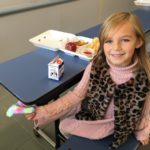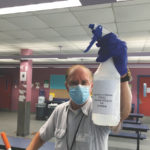
TRURO — In a school across from Truro’s vines, stood 113 children in nearly straight lines. It was a scene that evoked the melodious words of Ludwig Bemelman’s Madeline. The hope is that the order and regimentation imposed on the students at Truro Central School will help contain the coronavirus.
The students returned for in-person instruction on Sept. 28 to a completely transformed school, with an intense new layer of rules and sterile cleanliness in view on this reporter’s Oct. 9 visit.
“It’s all been hard,” said Principal Stephanie Costigan when asked what has been most difficult about preparing the school for classes while the virus still threatens. “Every aspect of our day has changed. I don’t think there is one single thing that hasn’t changed. That’s the hardest part.”
Costigan was the director of student services until this summer when Principal Robert Beaudet retired unexpectedly. Costigan took on the principal’s role and, with School Supt. Michael Gradone, she got to work on details large and small.
They separated each class — except for the first and second grades, which are so small they are combined for lunch and recess — into six insular pods, from preschool to fifth grade.
The coordination begins at parent or bus dropoff, when teachers and aides wait in different places to escort students through various entrances — the front door, the gym, the playground entrance — and then directly to their seats. Once at their assigned desks, someone will bring the students their free breakfasts. The U.S. Dept. of Agriculture has allowed all students to receive free meals due to the pandemic until funding runs out or Dec. 31, whichever comes first, said Heather Harper, the school’s administrator for business and finance.
The space outside each classroom has been cleared, leveled, and adorned with benches so that kids can to move in and out of doors within their allotted spaces until they go to lunch, when, as a single class with about four adult teachers, aides, and specialists, they enter a glittering cafeteria. Lunches have been cooked and packaged into Styrofoam containers and set on a cart in the middle of the room. Susie Roderick, the cafeteria manager, watches from a distance. She used to scoop meals onto trays and chat with the kids.
Each eight-foot-long table is shared by just two children, one at each end. All of the students face in the same direction, as if riding a really big bus, and then they put their masks on hooks attached to the ends of the tables to eat. The adults bring them their lunches; the kids may not leave their seats.
Afterwards, the children exit to the playground, where, finally, they can be free to play, as long as they don’t take off their masks. (Mask breaks are allowed on the sidelines.)
If, at any point, they forget about the masks, an adult will say, “I see your nose.”
Every seat is assigned, even at lunch, Costigan said, so that if someone tests positive for Covid-19, school nurse Helen Grimm can do contact tracing. Although, Costigan added, no child or adult should ever become a close contact — meaning no one at Truro Central School should ever be unmasked within six feet of another person for more than 15 minutes.
When the students leave the cafeteria, Joe Maroon, an 80-year-old part-time custodian, cleans the tables and the chairs with hypochlorus solution and gets ready for the next bunch.
After the kids exit the playground, the school’s head custodian, Drew Locke, squirts all the plastic and metal equipment from his electrostatic backpack sprayer. This disinfects everything but also makes him look like he is dousing the playground with insecticide.
The children cannot sing together, but they go outside and bang drums and they play the keyboards in the gym far apart from each other. Other “specials,” such as art, take place on the computer. Even the students who are in class do their art on their iPads. This allows the 27 Truro students who are staying home to get art instruction at the same time as their classmates, Costigan explained. Teachers must teach simultaneously to kids in and out of school.
“You have to hold back with the hands-on learning,” said Bruce Lampman-Perlman, a.k.a. “Mr. L.P.,” who teaches first grade. “You can’t give them books. So, you have to show (the books) to them.”
Costigan said the students are doing really well and accepting the new rules far better than she thought they would.
Barbara Braun, a clinical nurse specialist for children and adolescents and a licensed mental health counselor who practices in Orleans, said the new rules are worth the price.
“The kids are adapting to the masks because they want to see their friends,” said Braun, who works with kids age five and up. “I haven’t heard any of my kids complaining about the excessive new rules.”
At the same time, Braun said, “Kids need to be free. They need expression and socialization.”
The virus provides more reasons to be anxious, and most of her clients are already very anxious. Screen time is on overload, she said, and parents are giving up their rules about it.
“But it is what it is,” she said. “Kids are resilient. Think of what kids have been through in history.”






